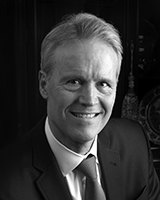
David B. Hellmann,
M.D., M.A.C.P.
Throughout this year, we have been celebrating a landmark anniversary: 125 years of the Johns Hopkins University School of Medicine. Believe it or not, before the school opened its doors in 1893, medical students here in the United States could complete their entire education without ever seeing a patient. All that changed under the leadership of William Osler – considered by many historians to be the greatest physician North America has ever produced. Osler inspired students and faculty members at the nascent school of medicine to put the patient first, famously advising at a 1903 lecture: “For the junior student in medicine or surgery, it is a safe rule to have no teaching without a patient for a text, and the best teaching is that taught by the patient himself.”
All these decades later, I am pleased to let you know that here at the Center for Innovative Medicine, we are holding true to Osler’s founding mission. In this issue’s cover story, “Investing in Genius” (p. 2), for example, you’ll read about young doctors such as Brian Garibaldi, who has launched an international Society for Bedside Medicine in response to growing concern that physicians are spending less and less time with patients. In addition, Brian and his team have developed an innovative new tool – a point-of-care ultrasound – aimed at opening up communication between doctors and patients. His work as the Douglas Carroll MD CIM Scholar is made possible through generous funding from Susan Immelt and her husband, in honor of Susan’s father. I think of such awards as “genius grants,” similar to the famous MacArthur Fellowships that are awarded as an investment in a person’s “originality, insight and potential.” Until now, we’ve been funding about two new CIM Scholars a year. My vision, with your help, is to see the number of “genius grants” we award grow dramatically – to 10 or more annually.
Elsewhere in this issue, you’ll find compelling stories about other Johns Hopkins doctors who are committed to Osler’s exhortation that “medicine is learned by the bedside and not in the classroom.” For Megan Buresh, that bedside is a mobile van parked outside the Baltimore City Detention Center, where she and her team provide immediate treatment for opioid use disorder to people being released from prison. Their efforts are part of the CIM’s ambitious “5 in 10” initiative, aimed at increasing the life expectancy of the underserved in our local community by at least five years over a decade (p. 10). For esteemed radiologist Elliot Fishman, a member of the Miller Coulson Academy, clinical excellence means tapping into the latest technology to find and diagnose disease at an earlier stage, when it is easier to treat and even cure (p. 7).
Speaking of the Miller Coulson Academy of Clinical Excellence, I am pleased to note that this year marks an important milestone for the CIM: the 10th anniversary of the Academy, launched in 2008 through the vision and generosity of the Miller Coulson family. Now numbering 81, the standout physicians in the Miller Coulson Academy are truly a force for good, providing compassionate care to patients and families day after day, and sharing their expertise with students, trainees and colleagues. And this year, with the launch of the medical education website CLOSLER (p. 17), the reach of the Miller Coulson Academy has extended beyond the walls of Johns Hopkins – to doctors around the globe.
Clearly, we’ve got a lot to celebrate and be excited about, as 2018 winds down. We also have much to be thankful for: most notably your commitment to supporting the CIM in our continued efforts to make medicine a public trust.

Aliki Perroti Professor of Medicine;
Vice Dean, Johns Hopkins Bayview Medical Center;
Chairman, Department of Medicine